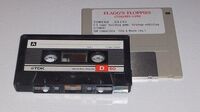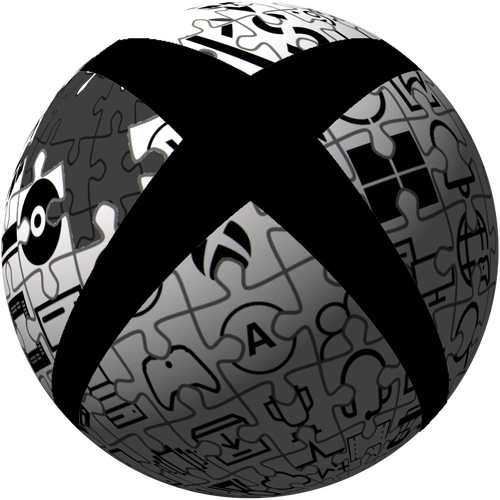A video game console is an interactive entertainment computer or electronic device that produces a video display signal which can be used with a display device (a television, monitor, etc.) to display a video game. The term "video game console" is used to distinguish a machine designed for consumers to buy and use solely for playing video games from a personal computer, which has many other functions, or arcade machines, which are designed for businesses that buy and then charge others to play.
Use of the term[]
The "video" in "video game console" traditionally refers to a raster display device.[1] However, with the popular use of the term "video game" the term now implies all display types and formats. The term "console" is used in the user manuals of several early video game systems. Its use, however, is not synonymous with "video game system" or the same as its modern usage. It refers to a specific part of the video game system. The Atari 2600, NES, and other consoles from those decades were called "video game systems" at the time.[2][3]
The first company to use the term "console" to officially refer to its video game system was Fairchild with the Video Entertainment System (VES) in 1976.[4] Since then, definition has widened to include entire systems, as well as to describe alternate platforms such as handheld game consoles, TV games, and multimedia devices.[5] In common usage a "console" is a specialized electronic device that connects to a standard television set or composite video monitor. A "handheld" gaming device is a self-contained electronic device that is portable and can be held in a user's hands.
Common elements[]
- Controllers: Devices that allow the user to input information and interact with onscreen objects. They are like the keyboards and joysticks of personal computers.
- Power supply: a power supply converts 100-240 volt AC utility power into direct current (DC) at the voltages needed by the electronics.
- Console/Core Unit: The core unit in a video game console is the hub where the television, video game controllers, and game program connect. It usually contains a CPU, RAM, and an audiovisual coprocessor. Core units are similar to towers of personal computers.
- Game Media: Most video game consoles have their programs stored on external media. They are the ROM of consoles.
- Memory Card: Some video game consoles, like the PlayStation and the Nintendo GameCube have memory cards to save, load, and delete files. Though recent consoles such as the Xbox, Xbox 360, PlayStation 3, and Wii all have – or can have installed – hard drives/internal memory which save the data on the console itself. Memory cards are like flash drives for consoles.
Bits[]
Each new generation of console hardware made use of the rapid development of processing technology. Newer machines could output a greater range of colors, more sprites, and introduced graphical technologies such as scaling, and vector graphics. One way this increase in processing power was conveyed to consumers was through the measurement of "bits". The TurboGrafx-16, Sega Genesis, and SNES were among the first consoles to advertise the fact that they contained 16-bit processors. This fourth generation of console hardware was often referred to as the 16-bit era, and the previous generation as the 8-bit.
The bit-value of a console referred to the word length of a console's processor (although the value was sometimes misused, for example the TurboGrafx 16 had only an 8-bit CPU, and the Genesis/Mega Drive had the 16/32 bit Motorola 68000, but both had a 16-bit dedicated graphics processor). As the graphical performance of console hardware is dependent on many factors, using bits was a crude way to gauge a console's overall ability, but served better to distinguish between generations.
Media[]
Cartridges[]

Standard game cartridges for several popular consoles. From front to back: Game Boy Color, Sega Genesis, and Atari 2600.
Game cartridges consist of a printed circuit board housed inside of a plastic casing, with a connector allowing the device to interface with the console. The circuit board can contain a wide variety of components. All cartridge games contain at the minimum, read only memory with the software written on it. Many cartridges also carry components that increase the original console's power, such as extra RAM or a coprocessor. Components can also be added to extend the original hardware's functionality[6] (such as gyroscopes, rumble packs, tilt-sensors, light sensors, etc.); this is more common on handheld consoles where the user does not interact with the game through a separate video game controller.[7]
Cartridges were the first external media to be used with home consoles and remained the most common until 1995 continued improvements in capacity (Nintendo 64 being the last mainstream game console to use cartridges).[8] Nevertheless, the relatively high manufacturing costs saw them completely replaced by optical media for home consoles by the early 21st century, although they are still in use in some handheld video game consoles.
Due to the aforementioned capabilities of cartridges such as more memory and coprocessors, those factors make it harder to reverse engineer consoles to be used on emulators.
Cards[]
Several consoles such as the Sega Master System and the TurboGrafx-16 have used different types of smart cards as an external medium. These cards function similar to simple cartridges. Information is stored on a chip that is housed in plastic. Cards are more compact and simpler than cartridges, though. This makes them cheaper to produce and smaller, but limits what can be done with them. Cards cannot hold extra components, and common cartridge techniques like bank switching (a technique used create very large games) were impossible to miniaturize into a card in the late 1980s.[9][10]
Compact Discs reduced much of the need for cards. Optical Discs can hold more information than cards, and are cheaper to produce. The Nintendo Gamecube and the Playstation 2 use memory cards for storage, but the Nintendo DS is the only modern system to use cards for game distribution. Nintendo has long used cartridges with their Game Boy line of hand held consoles because of their durability, small size and low battery consumption. Nintendo switched to cards for the DS, because advances in memory technology made putting extra memory on the cartridge unnecessary.[11]
Magnetic media[]

Two common forms of magnetic media. From front to back: Cassette and 3½-inch floppy disk.
Home computers have long used magnetic storage devices. Both tape drives and floppy disk drives were common on early microcomputers. Their popularity is in large part because a tape drive or disk drive can write to any material it can read. However, magnetic media is volatile and can be more easily damaged than game cartridges or optical discs.[12]
Among the first consoles to use magnetic media were the Bally Astrocade and APF-M1000, both of which could use cassette tapes through expansions. In Bally's case, this allowed the console to see new game development even after Bally dropped support for it. While magnetic media remained limited in use as a primary form of distribution, two popular subsequent consoles also had expansions available to allow them to use this format. The Starpath Supercharger can load Atari 2600 games from audio cassettes; Starpath used it to cheaply distribute their own games from 1982 to 1984 and today it is used by many programmers to test, distribute, and play homebrew software. The Famicom Disk System was released by Nintendo in 1985 for the Japanese market. Nintendo sold the disks cheaply and sold vending machines where customers could have new games written to their disks up to 500 times.[13]
Optical media[]

The most widely used forms of optical media are DVDs and compact discs. Shown is a CD-ROM (left) and a game in Nintendo's proprietary optical disc format.
In the mid-1990s, various manufacturers shifted to optical media, specifically CD-ROM, for games. Although they were slower at loading game data than the cartridges available at that time, they were significantly cheaper to manufacture and had a larger capacity than the existing cartridge technology. By the early 21st century, all of the major home consoles used optical media, usually DVD-ROM or similar disks, which are widely replacing CD-ROM for data storage. The PlayStation 3 system uses even higher-capacity Blu-ray optical discs for games and movies while the Xbox 360 formerly used HD DVDs in the form of an external USB player add-on for movies, before it was discontinued. Microsoft still however, supports those who bought the accessory.
Internet distribution[]
All three seventh generation consoles (the PlayStation 3, Wii, and Xbox 360) offer some kind of Internet games distribution service, allowing users to download games for a fee onto some form of non-volatile storage, typically a hard disk or flash memory.
Recently the console manufacturers have been taking full advantage of Internet distribution with arcade games, television shows and film trailers being available.
- Microsoft's Xbox Live service includes the Xbox Live Arcade and Xbox Live Marketplace, featuring digital distribution of classic and original titles. These include arcade classics, original titles, and games originally released on other consoles. The Xbox Live Marketplace also includes many different hit movies and trailers in high definition, and is accessible with a free Xbox Live Silver Membership.
- Sony's online game distribution is known as the PlayStation Network (PSN). It offers free online gaming, downloadable content such as classic PlayStation games, high definitio games and movie trailers, and original games such as flOw and Everyday Shooter as well as some games that also release on Blu-ray Disc such as Warhawk and Gran Turismo 5: Prologue. A networking service, dubbed PlayStation Home, is due for release in Fall 2008. Sony also announced a video/movie service and music service for some time in 2008.
- Nintendo 64, Sega Genesis/Mega Drive, NES/Famicom, TurboGrafx-16, SNES/Super Famicom, Neo Geo and Sega Master System/Game Gear, (In addition to Commodore 64 in Europe, and MSX in Japan), games are currently being emulated on the Wii console through Nintendo's Virtual Console service. Nintendo also has original content available for download through its WiiWare service.
References[]
- ↑ PONG-Story: Main page
- ↑ "Atari 2600 Game Catalog Scans (archived)
- ↑ Atari 2600 Manuals Scans (archived)
- ↑ Channel F manual (archived)
- ↑ Dominic Arsenault. "Company Profile: Nintendo" (PDF). Université de Montréal. Archived from the original on 2007-09-26. Retrieved on 2008-04-15.
- ↑ Dauer, James (March 20 2006). "Sonic: A History - From South Island to Cosmic Eternity". Retrieved on 2007-06-09.
- ↑ Kevin Horton (April 18 1997). "Cart Information" (.txt). 6.00. Retrieved on 2007-06-09. (archived)
- ↑ Polsson, Ken (May 9 2007). "Chronology of Video Game Systems". Retrieved on 2007-06-09.
- ↑ Richard Talbot-Watkins (June 10 1998). "SEGA MASTER SYSTEM TECHNICAL INFORMATION" (.txt). Retrieved on 2007-06-09.
- ↑ Jeff Bogumil (September 27 1997). "SEGA MASTER SYSTEM Frequently Asked Questions" (.txt). 2.06. Retrieved on 2007-06-09.(archived)
- ↑ "Nintendo DS Details Explosion - Screen, Battery, GBA Compatibility and More" (January 29 2004). Retrieved on 2007-06-09.
- ↑ Swearingen, Kirsten; Peter Charles, Nathan Good, Laheem Lamar Jordan, Joyojeet Pal. "How Much Information? 2003". Retrieved on 2007-06-20.
- ↑ "Family Computer Disk System" (January 20 2000). Retrieved on 2007-06-20.
Further reading[]
- Forster, Winnie (2005). The Encyclopedia of Game Machines - Consoles, handheld & home computers 1972-2005. Gameplan. ISBN 3-00-015359-4. http://www.gameplan-books.com/gameplan_01.5_NA/.
